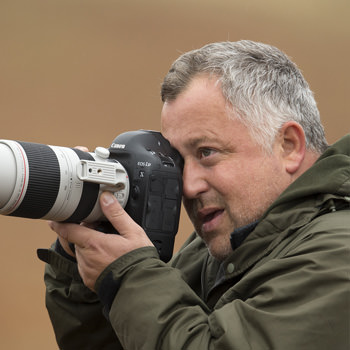I am Danny Green, a wildlife photographer based in the UK. I have had a deep fascination with the natural world since a child and I have been extremely lucky to be able to turn my passion into a career as a photographer. One of my great passions is capturing images of birds and I have travelled to many parts of the world in search of the perfect bird image.
Humans are fascinated by a bird’s ability to fly and so it is no wonder that birds are amongst the most popular of subjects for fellow photographers. Capturing images of birds in flight is extremely difficult but with the technology available in modern cameras this has made our job much easier. I started out using transparency film and when I look back at my old images I realised that I have very little in the form of action shots. Not so much the case now though as modern cameras have the fast auto focusing capacity and frame count, so the bar is constantly rising. I mainly use long telephoto lenses in the range of 500mm or 600mm for capturing images of birds.
Using these lenses gives you the reach you need but they are extremely heavy with all that glass, so you do need a sturdy tripod to support the weight.
I use the Gitzo Systematic range for this job, a very sturdy tripod that can face up to the rigors of working in a challenging environment. It is very difficult to keep up with tracking of the auto focus of a bird in flight and so you do need the right tripod head for the job. I use the Gitzo Gimbal Fluid head for all of my photography with these long lenses. The panning action of the head is so smooth it feels like you are hand holding the camera which makes it much easier to follow the birds. Finding the perfect place to photograph birds in flight can be tricky but a good place to start is a seabird colony, especially during the summer peak time as there can be a hive of activity with birds coming and going to feed their chicks.
I also like to incorporate the birds environment into my images too were I can. Birds can live in beautiful places and so it can be important to show that. It also mixes up your portfolio from an all action affair and when I am photographing a particular subject I will always try and capture a varied sequence. I use different techniques to capture these kinds of images. The most obvious one is to use a wide-angle like a 24-70mm. This will show up the environment more but the subject matter can get lost in the process sometimes, you also have to get extremely close for this kind of approach and that can be impossible with certain species. The approach I really like is to use the longer telephoto lenses but be further away from the subject and so show more of the environment with the bird much smaller in the frame. I call them birds capes and done correctly can give you a really good perspective. The background doesn’t have to be sharpe but you can distinguish it and so be able to place it.
I always say that light is the key for good photography no matter what genre you shoot. I learnt about lighting conditions from an old master in the studio and he was a genius at getting the best out of his old kit. Just by tweaking the power or altering the angle produced completely different results. I followed his approach in the way I work in the field and so I am always on the lookout for getting the best conditions or just making adjustments to my angle. It makes me obsessed with looking at weather forecasts and I have about ten different apps on my phone, usually they are all inaccurate but I at least try. Getting to work in the best light is one of the reasons why I take so long to work on a certain subject or project; I am always searching for the best light. It can be just the normal working with the sun on your back but waiting for that golden hour when the sun is low in the sky or just reposition yourself to maybe shoot into the sun which produces wonderful rim-lighting or silhouettes. I always advice people to work with the light as I believe it is the most important ingredient.




























